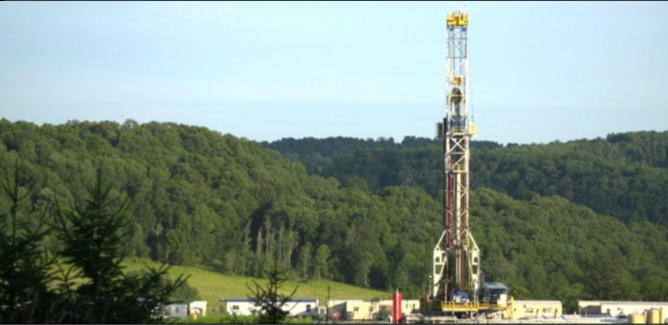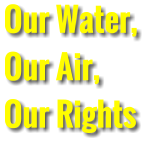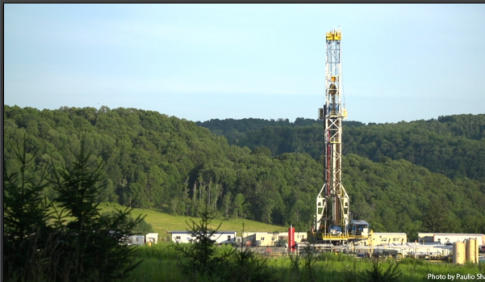

The mission of Our Water, Our
Air, Our Rights is to help people
protect their right to clean air,
pure water, and to the preser-
vation of the natural, scenic,
historic and esthetic values of the
environment. We acknowledge
that Pennsylvania's public natural
resources are the common
property of all the people,
including generations yet to
come. Our Water, Our Air, Our
Rights, through its educational
programs and other actions, shall
strive to preserve and protect
these rights for the benefit of all
the people.

Overview
FracTracker Alliance website: Dedicated to providing comprehensive up-to-date information regarding all aspects and phases of unconventional shale development in the U.S. and internationally. Articles, interactive maps and other resources (photos and videos) cover topics such as climate change, environmental impacts, health issues, oil and gas extraction primer, oil and gas well locations, infrastructure, legislation and social and economic issues. https://www.fractracker.org/ State Impact website: https://stateimpact.npr.org/ This NPR site provides frequent updated news articles focusing on energy economies and issues in Pennsylvania (https://stateimpact.npr.org/pennsylvania/), Texas (https://stateimpact.npr.org/texas/) and Oklahoma (https://stateimpact.npr.org/oklahoma/), as well as education in Florida, Indiana and Ohio.Public Health Issues
PSE Healthy Energy website: http://www.psehealthyenergy.org Internationally-renowned physicians, scientists and engineers (PSE) have joined forces to create an exceptional comprehensive website that looks at up-to-date peer-reviewed scientific articles on renewable energy, unconventional shale development, fracking and climate change and their potentially hazardous effects on public health. Educational resources include high-quality videos, links to scientific journals, articles and data sources, and even continuing medical education modules for physicians. Common questions and misperceptions about fossil fuels and sustainable energy are addressed in their FAQ section. Physicians for Social Responsibility (PSR) website: http://www.psr.org/ Discusses several environmental and health issues related to fracking and other human activities. Their comprehensive publication, co-released with Concerned Health Professionals of NY, is the Compendium of Scientific, Medical and Media Findings Demonstrating Risks and Harms of Fracking (Unconventional Gas & Oil Extraction), 5 th edition, March 2018. This extensive document summarizes several hundred evidence- based peer-reviewed scientific and medical articles on public health and climate change risks from unconventional shale development. It is a must-read for those who want to know the scientific TRUTH about how dangerous these activities are. https://www.psr.org/wp-content/uploads/2018/04/Fracking_Science_Compendium_5.pdf A Public Health Review of High Volume Hydraulic Fracturing for Shale Gas Development. NYS Department of Health. Dec 2014. https://www.health.ny.gov/press/reports/docs/high_volume_hydraulic_fracturing.pdf This free publication, authored by the New York State Department of Health, explores potential public health issues related to unconventional shale development and fracking, including impacts tied to contamination of drinking water, surface-water and air. Community and climate change impacts are also discussed. The information contained within this document, which was compiled over a seven-year period, assisted citizens, legislators and Governor Cuomo decide to institute a complete ban on fracking and unconventional shale development in New York State in 2015. US Department of Labor Occupational and Safety Health Administration (OSHA)--Oil and Gas Workers website: https://www.osha.gov/SLTC/oilgaswelldrilling/ According to OSHA data compiled from 2003-2010, oil and gas workers have seven-times the fatality rate directly related to their profession, compared with all other U.S. industries. This website describes injuries and other health-related problems that can result from working in various phases of oil and gas development. Hazards include manual tank gauging and sampling at oil and gas extraction sites, well drilling and servicing, exposure to silica (frac sand), oil and chemical spill response, explosions and fires, radiation and chemical exposures and others. EPA Study Linking Water Contamination to Hydrofracturing (2016) On December 13, 2016, the U.S. Environmental Protection Agency (EPA) released its final report Hydraulic Fracturing for Oil and Gas: Impacts from the Hydraulic Fracturing Water Cycle on Drinking Water Resources. https://www.epa.gov/hfstudy This report discusses scientific research over the past several years that shows a direct link between activities involved in the hydrofracturing (“fracking”) process and drinking water contamination. The Executive Summary, Assessment Report and other important information can be obtained at the EPA website: https://cfpub.epa.gov/ncea/hfstudy/recordisplay.cfm?deid=332990 Chemicals Used in Hydraulic Fracturing. U.S. House of Representatives Committee on Energy and Commerce Minority Staff. April 2011. This official U.S. government document lists over 700 chemicals that can be used in fracking, and discusses many of those that are used commonly along with their associated toxicities and potential adverse public health effects. Discusses proprietary (“trade secret”) chemicals excluded from regulation by Safe Drinking Water Act. http://www.conservation.ca.gov/dog/general_information/Documents/Hydraulic%20Fracturing%20Report%2 04%2018%2011.pdf Agency for Toxic Substances and Disease Registry (ATSDR) website: This U.S. federal public health agency site lists many of the chemicals used in hydraulic fracturing and their potential health effects, if known. It also lists many other environmental toxins and discusses various aspects of environmental medicine. https://www.atsdr.cdc.gov/az/a.htmlClimate Change Issues
EPA Home Climate Change website: Comprehensive topics related to the science of climate change that discuss causes, greenhouse gases, health effects and current and future environmental impacts. Also information is available on the Clean Air Act, Clean Water Act and other laws. https://www.epa.gov/climatechange The Impacts of Climate Change on Human Health in the United States: A Scientific Assessment. U.S. Global Change Research Program. April 2016. https://health2016.globalchange.gov/ This website discusses scientific and other public information regarding the threats of on-going climate change and its current and future potential effects on health. Topics include temperature-related impacts, food, air and water quality, vector-borne diseases, and psychological issues. Climate change and global warming are driven by continued burning of fossil fuels (coal, oil, natural gas) and leakage of methane from well sites, compressor stations, and pipeline infrastructure. NASA Climate Change website: This interactive site explores climate change evidence, causes, and effects and offers potential solutions. Scientific information is updated constantly through observation from the earth and satellites. http://climate.nasa.gov/ Pennsylvania Climate Impacts Assessment Update 2015. http://www.elibrary.dep.state.pa.us/dsweb/Get/Document-108470/2700-BK-DEP4494.pdf Pennsylvania State University researchers compiled this document for the Pennsylvania Department of Environmental Protection (PADEP). This document discusses hard scientific data about climate change and its causes and consequences, including economic, health, and environmental issues. Significant evidence of progressive global warming is the marked decline in Arctic perennial sea ice over the past three decades. Perennial sea ice is that ice that persists in the summer months and is at least four years old. From 1981-2016, NASA data and satellite imagery show an overall marked decline of perennial ice with a record low surface area set this past November. NASA Goddard research scientist Dr. Walt Meier shows us the extent of arctic ice loss over this period of time. This past year, 2016, is the third year in a row in which record global average high temperatures have been measured. We are already seeing major shifts in weather patterns and severity of storms. What will happen when all the ice is gone? What will happen to future generations? Our children? Our grandchildren?Regulation
Pennsylvania Department of Environmental Protection (PADEP) Oil and Gas Reports website: http://www.dep.pa.gov/DataandTools/Reports/Oil%20and%20Gas%20Reports/Pages/default.aspx Information about multiple facets of both conventional and unconventional oil and gas development including: laws, regulation, guidelines, policies, maps, permits, operators, well locations, well numbers, production reports, orphaned and abandoned wells, violations, spills, air and water contamination, water supply determinations, naturally occurring radiation (NORM), fines, wastewater treatment facilities and several other topics. Data from this regulatory agency clearly demonstrate that, in many cases, oil and gas extraction is not a safe or responsible activity and contributes to large numbers of violations and serious environmental and drinking water pollution cases. Fracking Failures: Oil and Gas Industry Environmental Violations in Pennsylvania and What They Mean for the U.S. Frontier Group and Environment America Research & Policy Center. Winter 2015. http://www.environmentamerica.org/sites/environment/files/reports/EA_PA_fracking_scrn.pdf This document discusses Pennsylvania’s top environmental and health violators and impacts of fracking and unconventional shale development. Public Herald website: Investigative journalism highlights hundreds of cases of Pennsylvania drinking water, air and other environmental contamination due to drilling, fracking and related activities, alleged DEP, EPA and oil and gas industry cover-ups and corruption. Official files and complaints to environmental regulatory agencies are available as are the DVD documentaries on unconventional shale development and impacts-- “Triple Divide” and “Invisible Hand”. http://publicherald.org/ Food and Water Watch, an organization that works to ensure the food and water we consume is safe, accessible and sustainable has authored an important paper titled The Urgent Case for a Ban on Fracking. The Environmental Integrity Project is a nonpartisan, nonprofit watchdog organization that advocates for effective enforcement of environmental laws. www.environmentalintegrity.org/
Resources



Photo by Paulio Shakespeare

The mission of Our Water, Our Air, Our Rights is to help
people protect their right to clean air, pure water, and to the
preservation of the natural, scenic, historic and esthetic
values of the environment. We acknowledge that
Pennsylvania's public natural resources are the common
property of all the people, including generations yet to come,
Our Water, Our Rights, through its educational programs
and other actions, shall strive to preserve and protect these
rights for the benefit of all the people.

Overview
FracTracker Alliance website: Dedicated to providing comprehensive up-to-date information regarding all aspects and phases of unconventional shale development in the U.S. and internationally. Articles, interactive maps and other resources (photos and videos) cover topics such as climate change, environmental impacts, health issues, oil and gas extraction primer, oil and gas well locations, infrastructure, legislation and social and economic issues. https://www.fractracker.org/ State Impact website: https://stateimpact.npr.org/ This NPR site provides frequent updated news articles focusing on energy economies and issues in Pennsylvania (https://stateimpact.npr.org/pennsylvania/), Texas (https://stateimpact.npr.org/texas/) and Oklahoma (https://stateimpact.npr.org/oklahoma/), as well as education in Florida, Indiana and Ohio.Public Health Issues
PSE Healthy Energy website: http://www.psehealthyenergy.org Internationally-renowned physicians, scientists and engineers (PSE) have joined forces to create an exceptional comprehensive website that looks at up-to- date peer-reviewed scientific articles on renewable energy, unconventional shale development, fracking and climate change and their potentially hazardous effects on public health. Educational resources include high-quality videos, links to scientific journals, articles and data sources, and even continuing medical education modules for physicians. Common questions and misperceptions about fossil fuels and sustainable energy are addressed in their FAQ section. Physicians for Social Responsibility (PSR) website: http://www.psr.org/ Discusses several environmental and health issues related to fracking and other human activities. Their comprehensive publication, co-released with Concerned Health Professionals of NY, is the Compendium of Scientific, Medical and Media Findings Demonstrating Risks and Harms of Fracking (Unconventional Gas & Oil Extraction), 5 th edition, March 2018. This extensive document summarizes several hundred evidence-based peer-reviewed scientific and medical articles on public health and climate change risks from unconventional shale development. It is a must-read for those who want to know the scientific TRUTH about how dangerous these activities are. https://www.psr.org/wp- content/uploads/2018/04/Fracking_Science_Compendiu m_5.pdf A Public Health Review of High Volume Hydraulic Fracturing for Shale Gas Development. NYS Department of Health. Dec 2014. https://www.health.ny.gov/press/reports/docs/high_volu me_hydraulic_fracturing.pdf This free publication, authored by the New York State Department of Health, explores potential public health issues related to unconventional shale development and fracking, including impacts tied to contamination of drinking water, surface-water and air. Community and climate change impacts are also discussed. The information contained within this document, which was compiled over a seven-year period, assisted citizens, legislators and Governor Cuomo decide to institute a complete ban on fracking and unconventional shale development in New York State in 2015. US Department of Labor Occupational and Safety Health Administration (OSHA)--Oil and Gas Workers website: https://www.osha.gov/SLTC/oilgaswelldrilling/ According to OSHA data compiled from 2003-2010, oil and gas workers have seven-times the fatality rate directly related to their profession, compared with all other U.S. industries. This website describes injuries and other health-related problems that can result from working in various phases of oil and gas development. Hazards include manual tank gauging and sampling at oil and gas extraction sites, well drilling and servicing, exposure to silica (frac sand), oil and chemical spill response, explosions and fires, radiation and chemical exposures and others. EPA Study Linking Water Contamination to Hydrofracturing (2016) On December 13, 2016, the U.S. Environmental Protection Agency (EPA) released its final report Hydraulic Fracturing for Oil and Gas: Impacts from the Hydraulic Fracturing Water Cycle on Drinking Water Resources. https://www.epa.gov/hfstudy This report discusses scientific research over the past several years that shows a direct link between activities involved in the hydrofracturing (“fracking”) process and drinking water contamination. The Executive Summary, Assessment Report and other important information can be obtained at the EPA website: https://cfpub.epa.gov/ncea/hfstudy/recordisplay.cfm?dei d=332990 Chemicals Used in Hydraulic Fracturing. U.S. House of Representatives Committee on Energy and Commerce Minority Staff. April 2011. This official U.S. government document lists over 700 chemicals that can be used in fracking, and discusses many of those that are used commonly along with their associated toxicities and potential adverse public health effects. Discusses proprietary (“trade secret”) chemicals excluded from regulation by Safe Drinking Water Act. http://www.conservation.ca.gov/dog/general_information /Documents/Hydraulic%20Fracturing%20Report%204%2 018%2011.pdf Agency for Toxic Substances and Disease Registry (ATSDR) website: This U.S. federal public health agency site lists many of the chemicals used in hydraulic fracturing and their potential health effects, if known. It also lists many other environmental toxins and discusses various aspects of environmental medicine. https://www.atsdr.cdc.gov/az/a.htmlClimate Change Issues
EPA Home Climate Change website: Comprehensive topics related to the science of climate change that discuss causes, greenhouse gases, health effects and current and future environmental impacts. Also information is available on the Clean Air Act, Clean Water Act and other laws. https://www.epa.gov/climatechange The Impacts of Climate Change on Human Health in the United States: A Scientific Assessment. U.S. Global Change Research Program. April 2016. https://health2016.globalchange.gov/ This website discusses scientific and other public information regarding the threats of on-going climate change and its current and future potential effects on health. Topics include temperature-related impacts, food, air and water quality, vector-borne diseases, and psychological issues. Climate change and global warming are driven by continued burning of fossil fuels (coal, oil, natural gas) and leakage of methane from well sites, compressor stations, and pipeline infrastructure. NASA Climate Change website: This interactive site explores climate change evidence, causes, and effects and offers potential solutions. Scientific information is updated constantly through observation from the earth and satellites. http://climate.nasa.gov/ Pennsylvania Climate Impacts Assessment Update 2015. http://www.elibrary.dep.state.pa.us/dsweb/Get/Documen t-108470/2700-BK-DEP4494.pdf Pennsylvania State University researchers compiled this document for the Pennsylvania Department of Environmental Protection (PADEP). This document discusses hard scientific data about climate change and its causes and consequences, including economic, health, and environmental issues. Significant evidence of progressive global warming is the marked decline in Arctic perennial sea ice over the past three decades. Perennial sea ice is that ice that persists in the summer months and is at least four years old. From 1981-2016, NASA data and satellite imagery show an overall marked decline of perennial ice with a record low surface area set this past November. NASA Goddard research scientist Dr. Walt Meier shows us the extent of arctic ice loss over this period of time. This past year, 2016, is the third year in a row in which record global average high temperatures have been measured. We are already seeing major shifts in weather patterns and severity of storms. What will happen when all the ice is gone? What will happen to future generations? Our children? Our grandchildren?Regulation
Pennsylvania Department of Environmental Protection (PADEP) Oil and Gas Reports website: http://www.dep.pa.gov/DataandTools/Reports/Oil%20an d%20Gas%20Reports/Pages/default.aspx Information about multiple facets of both conventional and unconventional oil and gas development including: laws, regulation, guidelines, policies, maps, permits, operators, well locations, well numbers, production reports, orphaned and abandoned wells, violations, spills, air and water contamination, water supply determinations, naturally occurring radiation (NORM), fines, wastewater treatment facilities and several other topics. Data from this regulatory agency clearly demonstrate that, in many cases, oil and gas extraction is not a safe or responsible activity and contributes to large numbers of violations and serious environmental and drinking water pollution cases. Fracking Failures: Oil and Gas Industry Environmental Violations in Pennsylvania and What They Mean for the U.S. Frontier Group and Environment America Research & Policy Center. Winter 2015. http://www.environmentamerica.org/sites/environment/f iles/reports/EA_PA_fracking_scrn.pdf This document discusses Pennsylvania’s top environmental and health violators and impacts of fracking and unconventional shale development. Public Herald website: Investigative journalism highlights hundreds of cases of Pennsylvania drinking water, air and other environmental contamination due to drilling, fracking and related activities, alleged DEP, EPA and oil and gas industry cover-ups and corruption. Official files and complaints to environmental regulatory agencies are available as are the DVD documentaries on unconventional shale development and impacts-- “Triple Divide” and “Invisible Hand”. http://publicherald.org/ Food and Water Watch, an organization that works to ensure the food and water we consume is safe, accessible and sustainable has authored an important paper titled The Urgent Case for a Ban on Fracking. The Environmental Integrity Project is a nonpartisan, nonprofit watchdog organization that advocates for effective enforcement of environmental laws. www.environmentalintegrity.org/
Resources

Our Water, Our Air, Our Rights


Photo by Paulio Shakespeare

















